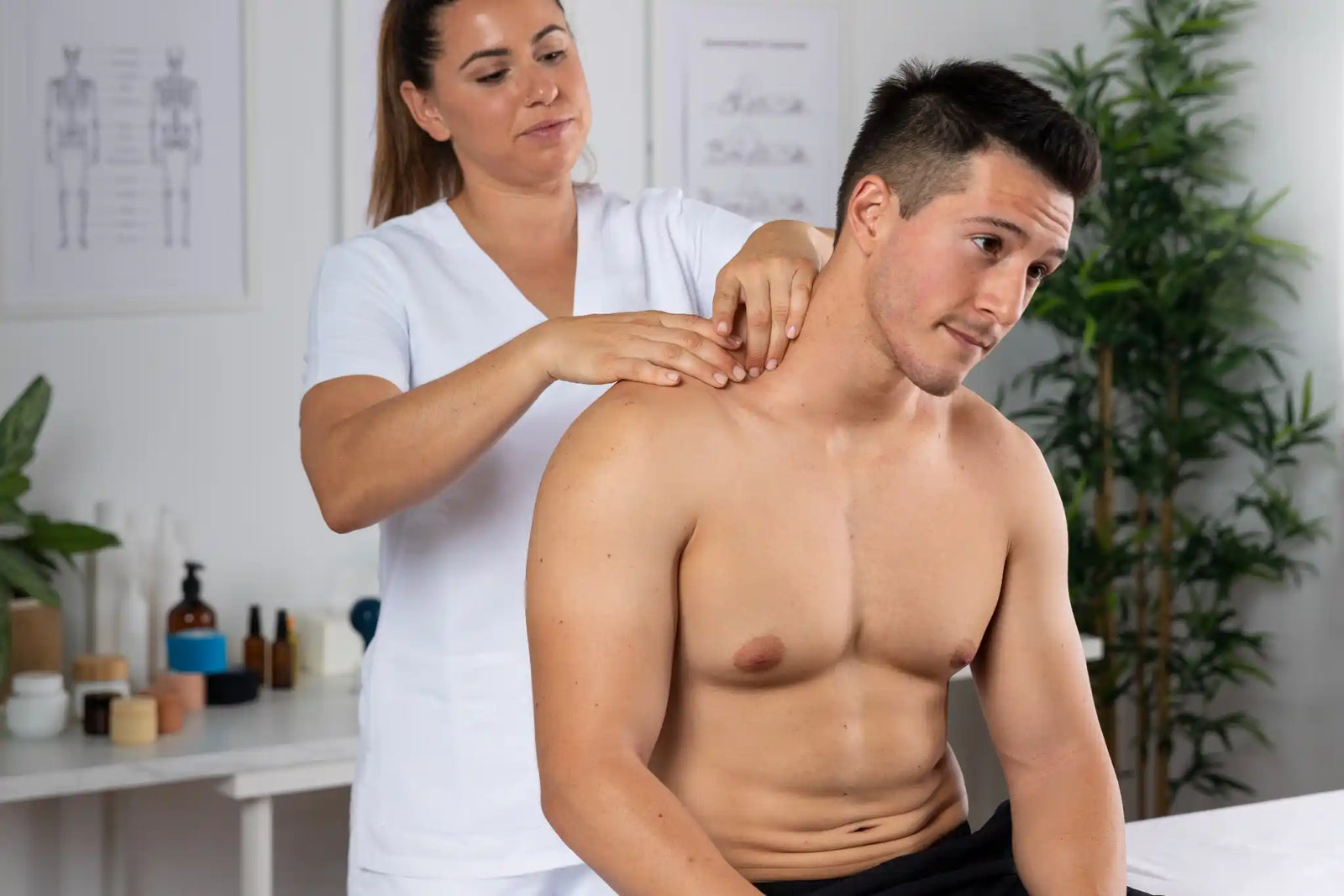Power of Touch: 9 Potential Benefits of Athletic Massages

Ever feel like your muscles have turned into concrete blocks after an intense training session?
Whether it’s relentless muscle soreness or a frustrating drop in energy halfway through a workout, recovery is a challenge every athlete knows all too well.
Massage therapy has long been popular among athletes, touted as a recovery tool with the potential to ease soreness, enhance relaxation, and support performance.
Research in this area reveals a mix of findings—some highlighting potential benefits, others showing minimal or no physiological impact.
What is consistent, however, is that many athletes report subjective improvements, citing massage therapy as a valuable addition to their recovery routines.
In this post, we'll dive into nine potential benefits of massages for athletes that you likely didn’t know about.
We'll explore current research findings while acknowledging that individual responses to treatment can vary significantly.
Let’s get into it!
Benefit 1: May Support Blood Flow and Circulation
Massage therapy has been explored as a way to potentially improve blood flow and circulation, particularly for athletes seeking to enhance recovery.
Some research suggests that massage could promote vasodilation—a process where blood vessels widen—potentially increasing circulation to muscle tissues.
In fact, a study found that massages significantly increased muscle blood volume and skin blood flow compared to simply resting—showing how effective this therapy can be.
The benefits also extend to the lymphatic system - our body's natural waste-removal mechanism. Massage techniques could potentially support this system in clearing metabolic byproducts from muscle tissues.
Quick Tip
Pair regular massages with proper hydration and foam rolling to amplify these benefits and keep your recovery on point.
Benefit 2: May Help With Muscle Recovery
Athletes have relied on massage therapy for centuries as part of their recovery routine. This is because another one of the potential benefits of massage for athletes is accelerated muscle recovery.
When integrated into a recovery protocol, massage might assist in reducing muscle tension and promoting relaxation.
Some athletes report feeling less muscle soreness and improved mobility after sessions.
In fact, a study published in the Journal of Physiology found that massage induced an anabolic response in muscles regrowing after atrophy.
Massages can also help replenish muscle glycogen stores - your body's preferred fuel source for intense exercise.
Additionally, they stimulate mitochondria - the energy factories inside cells.
By boosting mitochondrial activity, tissues receive more energy to power the repair process.
Quick Tip
Schedule a massage after your toughest workouts to help you bounce back stronger and perform pain-free.
Benefit 3: May Help Reduce Muscle Soreness
We’ve all felt it—the aching, stiff muscles that kick in a day or two after a tough workout.
That’s delayed onset muscle soreness (DOMS), often triggered by lactic acid buildup and tissue inflammation.
One of the potential massage benefits for athletes includes helping flush waste products like lactic acid out of tissues.
Massages also help reduce inflammatory compounds called cytokines. Produced by the immune system, cytokines signal tissue damage.
By regulating inflammatory cytokines, massage therapy alleviates pain and stiffness from delayed onset muscle soreness (DOMS).
Quick Tip
Combine regular massage sessions with a balanced post-workout meal to maximize recovery and build resilience.
Benefit 4: Helps Improve Range of Motion & Flexibility
Think of your muscles as rubber bands. When they're knotted and tight, they can't stretch to their full potential.
Massages can potentially work deep into these muscle tissues, breaking up stubborn adhesions that limit your movement.
When muscles move more freely, athletes may experience an enhanced range of motion during training sessions.
This could translate to more effective training sessions and potentially better recovery between workouts.
Plus, these loosened muscles give your joints the freedom to move naturally, reducing injury risk during intense training or from overtraining.
Quick Tip
Schedule a massage after your toughest workouts to help you bounce back stronger and perform pain-free.
Benefit 5: Helps Reduce Pain & Manage Chronic Injuries
For athletes, pain isn’t just an inconvenience—it’s a challenge to overcome.
While many turn to quick fixes like painkillers, massages offer a sustainable, drug-free solution that gets to the root of the problem.
One of the standout benefits of massages for athletes is their ability to target those stubborn muscle contractions and knots that can throw your entire body off balance.
By easing tension and relieving pressure on irritated nerves, massages help restore your body’s natural alignment.
And it doesn’t stop there.
Massage therapy purportedly stimulates the release of endorphins—your body’s natural painkillers—offering both immediate relief and long-term benefits.
Benefit 6: May Improve Posture and Body Awareness
Have you ever noticed how your body feels "off" after intense training sessions?
Athletic massages also help reset overworked muscles to their optimal resting length and tension.
This enhances proprioception, - your sense of body position and movement.
Massages can also help heighten sensory feedback from muscles and joints so you have a better awareness of your body. With improved proprioception, your athletic movements become more precise and coordinated.
Benefit 7: May Promote Cardiovascular Health
The benefits of massage for athletes aren’t just skin deep—they extend to your heart, too.
Traditional athletic wisdom suggests massage may support blood flow to working muscles. While research in this area continues to evolve, many athletes report feeling increased warmth and mobility post-massage.
By enhancing circulation and easing stress, massage can help keep your entire cardiovascular system in top shape, so you’re ready to take on your next challenge.
Benefit 8: Could Optimize Soft Tissue Health & Function
Your fascia—the connective tissue sheath wrapping around your muscles—plays a critical role in your mobility and performance. Neglecting it can lead to stiffness, restricted movement, and discomfort.
Massages help ensure your fascia stays flexible and responsive, promoting freedom of movement during training.
Additionally, massages can help enhance scar tissue management. The targeted pressure potentially encourages nutrient exchange at the cellular level. This, in turn, can help reduce inflammation and speed up tissue repair after intense workouts.
Benefit 9: Offers Various Psychological Benefits
Intense training can spike cortisol levels—the stress hormone that can hinder recovery.
Massages help to bring these levels back to baseline, activating your body’s parasympathetic nervous system (your “chill mode”).
This shift from a high-stress state to a recovery mode not only reduces stress but also encourages deeper sleep.
Increased delta brain waves from massages contribute to better sleep quality, which is key for physical and mental recovery.
Pack Up & Power Forward: From Massage To A Personalized Recovery Routine
Remember, the benefits of massage for athletes compound over time. Just like training, consistency with massage therapy yields the best results for your athletic performance.
But here's the thing - while massage therapy works wonders, it's just one piece of your recovery puzzle.
Studies show that genetics can influence athletic potential by as much as 66%! In fact, your genetic blueprint can also determine your recovery.
So, if you are wondering why your running buddy bounces back quickly from intense training, while you need extra recovery time - it's likely because of different genetic profiles.
This is where GENEFIT steps in. By analyzing your genetics, GENEFIT creates a recovery roadmap that's specific to you.
The app adjusts recovery protocols and suggests nutrition and lifestyle strategies based on your genetic profile and current training load.
Here’s a sample of GENEFIT’s recovery recommendations based on your genetic makeup:
Ready to take your recovery beyond the massage table?
Download the GENEFIT app today!FAQs
How often should athletes get massage?
The frequency of massages depends on your training intensity and recovery needs. Elite athletes often benefit from 1-2 massages per week during peak training, while recreational athletes might need one every 2-4 weeks.
Remember, the benefits of massage for athletes multiply when you maintain consistency in your massage.
What types of massage are best for athletes?
Sports massages and deep tissue work are the gold standards for athletic performance. Swedish massages help with general muscle tension, while trigger point therapy targets specific problem areas.
The massage benefits for athletes vary based on timing too. Pre-event massages should be lighter to warm up muscles, while post-event sessions can go deeper to aid recovery.
Want the best results? Mix different techniques based on your training phase and your body's needs.
Is it okay to get a massage right before or after a competition?
Pre-competition massages should be light and quick (15-20 minutes) to avoid muscle fatigue. Schedule them 48-72 hours before your event.
Post-competition, wait at least 2-3 hours after finishing to allow your body to stabilize.





